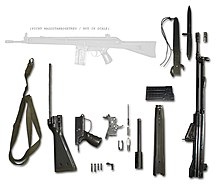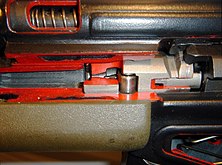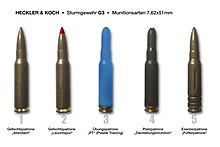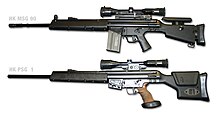HK G3
| HK G3 | |
|---|---|
 from above: HK G3A4, G3A3 from above: HK G3A4, G3A3
|
|
| general information | |
| Civil name: | Rifle 3 |
| Military designation: | G3 |
| Country of operation: |
|
| Developer / Manufacturer: | Heckler & Koch and others |
| Development year: | 1950 |
| Manufacturer country: | Germany and licensees |
| Production time: | since 1958 |
| Model variants: | see model variants |
| Weapon Category: | Rapid fire rifle |
| Furnishing | |
| Overall length: | 1025 mm |
| Total height: | 220 mm |
| Total width: | 58 mm |
| Weight: (unloaded) | 4.38 kg |
| Technical specifications | |
| Caliber : | 7.62 × 51 mm NATO |
| Possible magazine fillings : | 5/10/20 cartridges |
| Ammunition supply : | Bar magazine |
| Cadence : | 600 rounds / min |
| Fire types: | Single fire , continuous fire |
| Number of trains : | 4th |
| Twist : | right |
| Visor : | Rear sight |
| Closure : | movably supported roller lock |
| Charging principle: | Recoil loader |
| Lists on the subject | |
The G3 ( G ewehr 3 ) is a rapid fire rifle from the German weapons manufacturer Heckler & Koch (HK). It uses the 7.62 × 51mm NATO cartridge .
Introduced in 1959 as a standard rifle in the German Armed Forces , it was and is still used in many other armies. The weapon has been exported to many countries over the years and manufactured under license in at least 15 countries, bringing the total number of pieces built to around 7 million pieces.
In German usage, it is technically referred to as a rapid fire rifle due to the conventional rifle caliber . In English usage, the G3 is because of its properties as a Battle Rifle (gun battle) and not as Assault Rifle ( assault rifle classified).
history
The original concept of the G3 goes back to the Mauser development of the assault rifle 45 for the Wehrmacht . The first prototypes of the weapon, initially referred to internally as Device 06H by Mauser , were already tested in spring 1942. The concept of the rifle later called the Sturmgewehr 45 (M) , in contrast to the Sturmgewehr 44 introduced by the Wehrmacht, was not a gas pressure loader , but a recoil loader with a roller lock , which, however, only shortly before the end of the war due to the lengthy development and testing phase Left the prototype stage and was no longer produced in series. This corresponded to the functional principle of the MG 42 introduced . According to information in the literature, only about 30 weapons were assembled from the parts still produced after the end of the war under British supervision for test purposes.
Parts of the group under the engineer Ludwig Vorgrimler , responsible for the development at the time , went to France in 1946 to further develop their rifle concept on behalf of the government. The result of this development was the weapon that was ready for series production in 1949 and was called the AME 49 or Carabine Mitrailleuse 1950 , but the French army no longer procured it for financial reasons. The group under Vorgrimler then moved on to Spain in 1950 , where, at the request of the Spanish government, the specially founded company CETME ("Centro de Estudios Técnicos de Materiales Especiales") was to develop an assault rifle based on the movable roller lock.
As in France, a weapon designed for short cartridges like the 7.92 × 33 mm was initially designed during development . The result was a weapon initially manufactured in the 7.92 × 40 mm CETME caliber , known as the Modelo 2 . After the first official contacts to Germany had already been made in 1953, the Federal Border Police started testing the new rifle in 1954. However, at the official demonstration in January 1955, the caliber was rejected. The German authorities demanded the 7.62 × 51 mm NATO cartridge , which was later also introduced with the Belgian FN FAL (G1). The subsequently recalibrated rifle , known as CETME Model A , was subjected to extensive troop tests from autumn 1956 to January 1957 with the newly established Bundeswehr . Who then demanded changes in the ergonomic design of the front and rear shaft led to CETME Model B . Further changes to the sighting device as well as the pistol grip and the elimination of the originally planned bipod ultimately led to a weapon that was similar to the later CETME Model C. This was to be introduced to the Bundeswehr as the G3 rifle and thereby replace the FN FAL, which had only recently been procured, after a German license production had been rejected by the manufacturer FN . Licensing problems with the CETME company also stood in the way of the G3, but these were resolved by the Dutch company Nederlandse Wapen en Munitiefabrik (NWM) receiving a second license in return for ammunition delivery orders . This enabled the G3 to be introduced as the standard armament of the German Bundeswehr from 1959, presumably with more than a million units.
The weapon has been continuously developed over the years. In addition to the introduction of other versions, for example with a retractable shoulder rest, there were minor and major modifications. For example, wooden components have been replaced by plastic components on the front and rear stock and the original sighting device has been replaced by the HK-typical drum sights. In addition, shortly before the introduction of the G36 by the German Armed Forces, there was a revision in two points: A case deflector was supposed to steer the fired case forward / downward away from the shooter, and a new plastic handle housing made the safety lever engage better.
After almost 40 years of use of the G3 by the Bundeswehr, it was decided in December 1997 to replace it with the new G36 . In the course of the retrofitting, a large part of the weapons, mostly older vintages, had been destroyed since 2002 in order to prevent unwanted spread in crisis regions through subsequent sales that were no longer traceable. Nevertheless, there are still several hundred thousand G3 rifles in the Bundeswehr depots for national defense purposes, which are still being serviced, for example by retrofitting the above-mentioned sleeve deflector. In addition, G3 rifles are still available and ready for use in the armories of many Bundeswehr units.
Description & structure
concept

The G3 is a recoil loader with a fixed barrel and a movably supported roller lock . It is able to shoot both single fire and continuous fire. The weapon uses straight rod magazines made of aluminum or sheet steel with a capacity of 20 cartridges for cartridge feed.
The theoretical rate of fire is 600 rounds / min. Depending on the design and the ammunition used, the muzzle velocity is around 800 m / s with 2900 to 3400 joules of muzzle energy . Before delivery, every rifle was subjected to functional checks and a test fire. Five shots were fired at a target at a distance of 100 meters using particularly precisely loaded ammunition. The scattering circle of the projectiles could not be larger than 120 millimeters.
Assemblies
Like most infantry weapons, the G3 can be disassembled into its main assemblies in a few simple steps without tools. To do this, four bolts must be removed. In addition, some of the six assemblies can be further dismantled into their individual components:
- Housing with tube, loading and sighting device
- Housing with pressed tube and sighting device (drum sight & round front sight)
- Flash hider, interchangeable with maneuver cartridge device
- Clasp
- Bolt carrier
- Locking head with extractor
- Tax piece
- Firing pin
- Firing pin spring
- Handle, complete
- Handle
- Drain box
- Safety lever
- Shoulder rest with bottom piece
- Hand protection
- magazine
Repeating operation
If the weapon is finished loading , ie the front of the drive cartridge chamber located, a cartridge supplied and the shutter locks, a shot can be given after unlocking. By pulling back the trigger , the hammer integrated in the trigger case is released and strikes the firing pin . This hits the cartridge's primer , ignites the powder charge and the resulting powder gases drive the projectile through the barrel.
At the same time, the powder gases, which cannot escape from the otherwise closed barrel system because the bullet is in the barrel, press on the cartridge case. The force acting on the bolt head, which results in a return movement of the same, is transmitted via the bolt rollers integrated in the bolt head on the one hand to the weapon housing and on the other hand via the control piece to the bolt carrier. Specially coordinated angular relationships between the surfaces of the control piece delay the exit of the locking rollers from the abutments and thus the return movement of the locking head. This ensures that the sleeve supported by the breech seals the barrel until the bullet has left the muzzle.
Since the bolt head is not blocked when the shot is fired, but instead continuously moves slightly backwards, the case must be prevented from being torn by the still high gas pressure. For this purpose, pressure compensation grooves are milled into the tapered front part of the chamber in weapons with a delayed mass lock. The external pressure in the cartridge chamber is thus adjusted to the internal pressure in the case cone and the cylindrical part of the case.
After the lock rollers have completely entered the lock head, the lock slides further back in the weapon housing. The cartridge case is pulled out of the barrel's chamber using the extractor integrated in the bolt head. The bottom of the cartridge case runs against an ejector fixed at the bottom left and is ejected laterally to the top right.
The bolt carrier, which continues to return, pushes the hammer down into its initial position, where it engages in a catch. At the same time, the closing spring is tensioned and the rest of the return energy of the lock is absorbed and stored. In the rearmost position, the open central area between the lips of the magazine is released and the pressure of the magazine spring pushes the uppermost cartridge against one of the two magazine lips. The tensioned recoil spring pushes the bolt carrier forward again into the starting position, whereby a new cartridge is pushed from the magazine into the chamber through the front edge of the bolt head. The case base slides into the cylindrical recess of the bolt head and the spring-loaded extractor engages in the pull-out groove of the cartridge. The locking rollers are pressed by the inclined surfaces of the control piece out of the locking head into the so-called support surfaces of the weapon housing and thus lock the breech. This means that the weapon is ready to fire again.
When firing a single shot, the hammer is held in its cocked position by a catch after the return process. In the setting of the safety lever "F" ( burst of fire , i.e. continuous fire ), the catch and thus the cock are immediately released again when the bolt head is locked. The firing sequence is repeated until the trigger is released or the ammunition in the magazine has been completely fired.
equipment
In addition to a 4-way telescopic sight that could be mounted by a clamp assembly, the Bundeswehr used an “infrared target device for handguns” as additional optics, later replaced by the “image intensifier telescopic sight”. For shooting training, there is an insert barrel with a practice breech in caliber 5.6 × 15 mm .
A bayonet is also available as an accessory . It was never given to the troops across the board, but in the early 1980s it was in the so-called "barracks inventory". The blade is blunt on the sides, so has no cutting edge, and is designed as a pure stabbing weapon. Grinding or removal of the matt black coating had to be avoided (light reflection / glare effect). The bayonet was occasionally issued / procured by some units (e.g. floating bridge pioneers / M-boaters) on their own initiative in order to (then with a sharpened blade) as a "work knife" e.g. B. to cut ropes and ropes. For mounting on the weapon, it is also necessary to convert it with a bayonet adapter.
The grenade launcher HK79 in caliber 40 mm can be attached instead of the handguard. This was also not introduced in the Bundeswehr. However, all long barrel weapons can fire rifle grenades . For this purpose, a propellant charge cartridge is manually fed into the cartridge chamber via the cartridge ejection window and a rifle grenade equipped with a sight is pushed onto the flash hider.
The most commonly supplied accessories are primarily carrying straps and the maneuver cartridge device, also known as a recoil amplifier . The latter is necessary because the blank cartridges used during exercises, due to the lack of a bullet, which briefly increases the pressure within the barrel, do not provide sufficient recoil to ensure that the locking system functions properly.
For certain shooting projects (e.g. for so-called shortened shooting at military training areas), the original lock of the G3 can be replaced by an unlocked ground lock. This is intended exclusively for firing practice ammunition (light blue colored plastic cartridge with brass bottom) in caliber 7.62 × 51 mm; a firing of combat ammunition is not possible. The “exercise lock G3” is accordingly marked with a “ÜB” stamp.
Model variants
When aiming in , particularly precise rifles with a range of 80 millimeters and less were factory-fitted with a quadruple rifle scope and delivered as G3 A3 ZF . While this model variant is otherwise a standard G3 A3, the G3 SG 1 version is a modified weapon. Here, too, particularly good shooting weapons were taken from the series production, but not modified, the trigger has a set trigger with trigger stop , the piston has a cheek piece, and there is a hand guard with mounted bipod used. Furthermore, the G3 SG 1 uses a fixed, adjustable 1.5 to 6-fold magnifying telescopic sight.
- HK G3, original version with wooden shoulder rest and folding visor.
- HK G3 A1, version of the G3 with retractable metal shoulder rest.
- HK G3 A2, version with fixed shoulder rest and new, rotatable diopter drum sight.
- HK G3 A3, version with fixed shoulder rest made of plastic and free-swinging barrel.
- HK G3 A3 ZF, scope rifle from series production.
- HK G3 A4, version of the G3 A3 with retractable metal shoulder rest.
- HK G3 SG 1, sniper rifle with set trigger, telescopic sight and bipod.
- HK G3 DMR, a performance-enhanced G3 SG1 with height and length adjustable shoulder rest, bipod and assault handle.
- HK G3 K, version with short (315 mm) barrel and retractable shoulder rest.
- HK G3 TGS, designation for a G3 with a mounted 40 mm HK 79 grenade launcher .
- HK 41, semi-automatic reservist rifle.
- HK 91, HK41 semi-automatic export model (mainly for the US market).
- HK SL7 , semi-automatic target shooting and hunting rifle with wooden stock.
- MC 51, compact version made by the British manufacturer FR Ordnance, similar to the HK 53 .
- POF G3M, licensed version of the G3 from the Pakistan Ordnance Factories with 450 mm total length, modified flash hider and Picatinny rail
The sniper rifles MSG90 / MSG3 and PSG 1, which are listed as “special weapons ” at Heckler & Koch and which have continued to be manufactured after the G3 was discontinued, are based on the heavily modified G3 housing system.
As of 2013, civilian self-loading rifles based on the HK41 version of the G3 are available from various manufacturers, which can be purchased for sport shooters and hunters. By modifying the grip and breech, it is not possible with these rifles to use parts from fully automatically functioning G3s, in order to exclude the dismantling into a war weapon forbidden for civilians.
commitment
Afghanistan
The G3 DMR is used again by the armed forces rifle scopes to fight targets at distances of up to 600 m or to use suppressive fire up to 800 m. The changes to the weapon include a Schmidt & Bender 3–12 × 50PMII on STANAG cocking assembly, handguard with Picatinny rail for LLM01 , Harris bipod and assault grip, as well as a single-fire locked grip. The G3 DMR are used by the Bundeswehr to close the gap between G36 and G22 .
Saudi Arabia
Saudi Arabia has had a license to manufacture the G3 for its own military use since 2008. However, in April 2015, the country passed on rifles of this type in support of the militia in the fight against the Houthi rebels by dropping them over Aden Airport . The German Federal Government's Ministry of Economic Affairs then admitted that a "physical end-use control of the G3 and G36 manufactured in Saudi Arabia", which the country also has licenses for, was "not possible on the basis of the underlying permits".
Users
The G3 and its versions have been exported to at least 80 countries. It was also found in Burma , Denmark (Gv M / 66) , France , Greece , Great Britain , Iran , Malaysia , Mexico , Norway (AG-3) , Pakistan , Portugal (M1961) , Saudi Arabia , Sudan , Sweden (Ak4 ) and Turkey manufactured under license. In most of these countries, the police and the military were also equipped with this weapon. At the turn of the millennium, the G3, of which about 7 million copies were made, was far behind the Kalashnikov (70-100 million copies) and next to the M16 and the FN FAL, one of the world's most widely produced military automatic fire rifles.
In Iran, various types of the G3 are manufactured in unknown quantities by the Defense Industries Organization and sold worldwide.
In the Federal Republic of Germany the weapon was also introduced to the state and federal police. At the customs border service, the G3 replaced the previously used ZK 52 carbine from 1974 . A slot system in caliber .22lfB was part of the weapon as standard. So far, it has hardly been used in exchanges of fire with criminals, but because of the higher energy output compared to pistol ammunition, it is occasionally used, for example, to kill escaped livestock . The G3 was and is also used in the judiciary as a weapon for guarding prisons. However, some federal states have now replaced them with a semi-automatic variant of the G36 (e.g. Brandenburg, Saxony).
In 1961 10,000 G3s were exported to Burma (now Myanmar), and a further 12,000 G3s were delivered in further export tranches. Burma received a production license in the 1960s and produced the G3 under the designation BA 72 and Burma Army 72. Other versions were the BA / Burma Army 63 with a retractable shaft and the BA / Burma Army 100 as a licensed version of the G3A3ZF. The G3 was the standard rifle used by the Burmese armed forces from the 1960s to the 1990s .
| Year of licensing | License recipient | Producer / location |
|---|---|---|
| 1961 | Portugal | Fabrica de Braco de Prata (FBDP) Industrias Nacionais de Defesa EP |
| 1963 | Pakistan | Pakistan Ordnance Factory (POF) |
| 1964 | Sweden | FFV (as Automatkarbin 4 (Ak 4)) |
| 1967 | Norway | Norsk Fors |
| 1967 | Iran | MWF, Mosalsalsasi |
| 1967 | Turkey | MKE |
| 1969 | Saudi Arabia | Al-Khardi A. |
| 1970 | France | MAS |
| 1970 | Great Britain | Royal Small Arms Factory, Enfield |
| 1971 | Thailand | AWPC |
| 1976 | Brazil | - |
| 1977 | Greece | Hellenic Arms Industry (EBO), has been operating as Hellenic Defense Systems (EAS) since the merger with PYRKAL in 2014 |
| 1979 | Mexico | Fabrica de Armas |
| 1981 | Myanmar (Burma) | State work |
| - | Philippines | - |
| - | Malaysia | Munora Holdings |
Swell:
Production Licensing Controversy
Heckler & Koch was criticized several times because of the award of G3 production licenses to 15 countries, including Iran and Myanmar . In 1989, the Armaments Information Office in Oberndorf, founded by Jürgen Grässlin , stated that “there is hardly a third world country without G-3 rifles”. The export permits are issued by the Federal Security Council of the Federal Government , which meets in camera.
Others
A G3 as a broken rifle is used by the organization Deutsche Friedensgesellschaft - United War Service Enemies in their logo.
literature
- ZDv 3/13 "The G3 rifle"
- TDv 1005 / 005-12 "G3 rifle"
- HK G3 Armorer's Manual Instructions for Maintenance and Repair Cal. 7.62 mm x 51
See also
Web links
- HK G3 . In: SALW Guide (technical data, distribution, images).
- Waffeninfo.net
- WaffenHQ.de
- G3 disassembled
- HKpro.com
- Handguns of the Bundeswehr - G3 rifle
- Bundeswehr Classix: G3 rifle is built (1970) ( YouTube video)
Individual evidence
- ^ DeutschesHeer.de: G3 rifle
- ↑ Federal Ministry of Defense (ed.): ZDv 3/13 Das Gewehr G3 . Bonn 1999, Chapter 5 Exercise Equipment Section III Exercise Lock.
- ^ Karl R. Pawlas: Waffen Revue No. 54 III. Quarter 1984 the automatic rifle G 3 and its history . Jornal Verlag Schwend GmbH, Schwäbisch Hall 1984.
- ↑ Pierangelo Tendas: FR Ordnance MC51. (SecurityArms.com) E-Image Agency, archived from the original on February 13, 2008 ; accessed on July 20, 2009 (English).
- ↑ Article IDEX 2013. French Ministry of Defense, September 22, 2009, accessed August 29, 2017 (French).
- ↑ Alexander Przewdzick / Björn Jüttner: Ready to shoot. In: Y The Bundeswehr magazine. Bundeswehr, November 2, 2010, accessed on November 8, 2010 .
- ↑ German rifles in Yemen: Federal government admits loopholes in arms export controls , Spiegel-Online from June 12, 2015
- ↑ Shattered lives report (2003), p. 21 ( Memento of September 2, 2009 in the Internet Archive )
- ^ Website of the Iranian arms manufacturer DIO (Defense Industries Organization). ( Memento from February 10, 2013 in the Internet Archive )
- ↑ Leroy Thompson: The G3 Battle Rifle . Osprey Publishing, 2019, ISBN 978-1-4728-2862-0 ( google.com ).
- ^ Der Spiegel, December 25, 1989: German around the world. Retrieved August 15, 2012; Gideon Burrows: The No-Nonsense Guide to the Arms Trade. Verso Books, 2002, ISBN 1-85984-426-X , p. 24; Jürgen Grässlin: Hide when they shoot. Munich 2003, p. 364
- ↑ Jürgen Grässlin: Hide when they shoot. The true story of Samiira, Hayrettin and a German rifle (PDF; 3.1 MB). Droemer Knaur, Munich 2003, pp. 392, 393.
- ↑ a b weapons. German around the world. All over the world, police officers and criminals, the military and guerrillas are shooting with a West German assault rifle . In: Der Spiegel No. 52, December 25, 1989.










